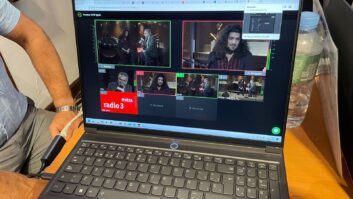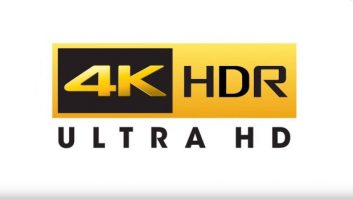2020 was an important year for 4K high dynamic range (HDR). After much debate in the early years, the HDR landscape has settled on a multi-format environment with both HLG [hybrid log-gamma] and PQ [perceptual quantizer] based formats for production. While set-top box refresh cycles slow the pace of rollout in pay TV and national DTT platforms, the world of streaming has been able to adopt and deliver HDR in a much quicker timescale with HDR readily available on a number of leading streaming platforms. As a result, HDR has been propelled to the forefront of content producers’ minds for both live and on-demand media experiences with content being increasingly mastered in HDR for longevity even if an SDR playout is derived from it.
HDR is increasingly being embraced within consumer electronic devices and live production techniques. The main HDR standards have been widely implemented and increasingly available at home with the majority of current 4K TV set purchases, giving consumers a taste of next-generation viewing experiences. End-to-end delivery of HDR is reliant on compression codecs that can support 10-bit or greater bit-depth. This coincides with the desire for compression codecs to increase the efficient delivery of 4K or higher resolutions.
4K HDR on-demand
HDR along with wide colour gamut offers a notable improvement to the light levels, highlights and range of colours that can be represented compared to historic TV formats including HD. All this creates a more lifelike and enthralling experience for the viewer at home.
Producers of on-demand episodic content have been capturing in HDR for many years to provide the best source for production. Due to the high cost of filming and producing content in native 4K HDR, this had been predominantly deployed for high-budget productions but has become more readily available for other productions with lowering equipment costs. More recently with streaming device and 4K TV adoption, the rest of the delivery chain has become capable of offering this experience to consumers. Episodic content has tended to favour Dolby Vision format for HDR.
Capturing content natively in 4K HDR emerged just under a decade ago when it first became financially feasible to do so within the realms of a high production budget. The latter four seasons of HBO’s Game of Thrones offer a prime example of this evolution. While the first three seasons were filmed in 10-bit 4:4:4 at 1920×1080 resolution, the latter four could leverage developments in production technology that emerged around 2013. According to The Digital Bits, they were shot in 3.2K Pro-Res and ARRIRAW format and finished in 4K.
Increasing the use of HDR production in live sports
Large-scale, big-budget shows such as Game of Thrones set a new precedent in how movie and episodic content were filmed and captured. However, for live content, the adoption of HDR technology has been slower. Broadcasters and content producers now have the tools needed to develop and deliver a richer, more lifelike picture quality for all media experiences. Attention is turning towards the live event landscape; particularly live sports where HDR can significantly boost the fan experience. Live production has tended to favour HLG format for HDR.
HDR technology is adept at adjusting to varying contrasts of bright sunlit scenes in a live production setting. In football games, HDR can easily adapt to the huge fluctuations in the contrast of a ball travelling through a sunny section of a pitch during a match without washing out the details that would usually happen in an SDR production. Major sports rights holders are now testing HDR technology for primary broadcast coverage, including Formula One, which praised the capabilities of HDR for capturing coverage of fast-moving objects. F1 is conducting tests on HDR broadcasting this year and announced it could be “the next stage of an offering” for racing fans.
Live sport is the biggest testbed for HDR at the moment. The 2021 Summer Olympics in Tokyo is set to mark Sky’s live HDR sport broadcast debut, offering exciting prospects for the viewing experience of the pinnacle on the live sports calendar. However, as live production tools become increasingly more efficient and the rollout of new codecs hastens, its application for other live content – such as concerts, festivals, and keynote speeches – will likely follow suit.
- Eurosport 4K to broadcast Olympics in UHD/HDR
- TVBEurope’s May issue: UHD, HDR and Formula One
- EBU investigates best practice for UHD/HDR
What happens to older content?
Viewer expectations for immersive, stunning-quality video experiences drive new native UHD/HDR content creation. However, content providers with extensive, much-loved content archives are often only made available in standards up to HD. The question now is: how do you raise the picture quality of old content (that can be up to 50 years old) to a good enough resolution for everyday consumption? Creating a new UHD/HDR asset with manual production is costly, and the visual results from applying traditional up-conversion techniques may not provide the desired experience.
Machine learning can perform advanced up-conversion using neural networks, creating up-converted images that are more akin to native UHD images. Up-conversion enables UHD channel viewing experiences that are visibly superior to HD services. Generative Adversarial Neural Networks can synthesise detail in the up-converted image to create a more compelling and higher quality experience.
Content owners, MPVDs, broadcasters, and service providers have a massive content library archive. Up-conversion creates new revenue potential of that content from SD to HD, or HD to UHD and beyond. This technique can be applied to film, drama, sports, and other content, making a significant impact on the end-user experience.
Looking to the future
Broadcasters will still need to determine which formats offer the best efficiency and cost savings for producing and delivering UHD/HDR content. MediaKind’s testing has found that Versatile Video Coding (VVC) will reduce bit rates by roughly 41 per cent and Essential Video Coding (EVC/MPEG-5 part 1) by 26 per cent compared with HEVC for delivering UHD content. This will make a significant difference for delivering content via OTT streaming, IPTV, digital terrestrial broadcast, and in instances of limited DTT bandwidth and satellite DTH.
Improvements to encoding standards such as VVC will significantly improve bandwidth requirements and allow broadcasters and streamers to develop and deliver a richer, more lifelike picture quality. As the popularity of immersive media experiences continues to surge, we will see a rapid increase in next-generation immersive UHD/HDR services coming to the market.







